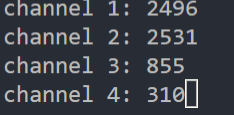I am trying to setup the following pins A1 (Pin 0.05) , A2 (Pin 0.06) , A3(Pin 0.07) & A4 (Pin 0.25) to read adc values using the nrf5340dk board. I have a joystick module connected to pins A1 & A2 and nothing is connected to pins A3 & A4 but for some reason i am still seeing values on the nrf terminal , i dont know what these values are and how can i setup the channels so that if nothing is connected i read only 0's ?

My code is shown below:
/*
* Copyright (c) 2020 Libre Solar Technologies GmbH
*
* SPDX-License-Identifier: Apache-2.0
*/
#include <inttypes.h>
#include <stddef.h>
#include <stdint.h>
#include <zephyr/device.h>
#include <zephyr/devicetree.h>
#include <zephyr/drivers/adc.h>
#include <zephyr/kernel.h>
#include <zephyr/sys/printk.h>
#include <zephyr/sys/util.h>
#include <zephyr/drivers/gpio.h>
#if !DT_NODE_EXISTS(DT_PATH(zephyr_user)) || \
!DT_NODE_HAS_PROP(DT_PATH(zephyr_user), io_channels)
#error "No suitable devicetree overlay specified"
#endif
#define DT_SPEC_AND_COMMA(node_id, prop, idx) \
ADC_DT_SPEC_GET_BY_IDX(node_id, idx),
/* Data of ADC io-channels specified in devicetree. */
static const struct adc_dt_spec adc_channels[] = {
DT_FOREACH_PROP_ELEM(DT_PATH(zephyr_user), io_channels,
DT_SPEC_AND_COMMA)
};
void main(void)
{
int err;
int16_t buf;
struct adc_sequence sequence = {
.buffer = &buf,
/* buffer size in bytes, not number of samples */
.buffer_size = sizeof(buf),
};
/* Configure channels individually prior to sampling. */
for (size_t i = 0U; i < ARRAY_SIZE(adc_channels); i++) {
if (!device_is_ready(adc_channels[i].dev)) {
printk("ADC controller device not ready\n");
return;
}
err = adc_channel_setup_dt(&adc_channels[i]);
if (err < 0) {
printk("Could not setup channel #%d (%d)\n", i, err);
return;
}
}
while (1) {
//printk("ADC reading:\n");
/*---------Channel A1 (Pin 0.04)--------*/
printk("\n channel %d: ",
adc_channels[0].channel_id);
(void)adc_sequence_init_dt(&adc_channels[0], &sequence);
err = adc_read(adc_channels[0].dev, &sequence);
printk("%"PRId16,buf);
/*---------Channel A2 (Pin 0.06)--------*/
printk("\n channel %d: ",
adc_channels[1].channel_id);
(void)adc_sequence_init_dt(&adc_channels[1], &sequence);
err = adc_read(adc_channels[1].dev, &sequence);
printk("%"PRId16,buf);
/*---------Channel A3 (Pin 0.07)--------*/
printk("\n channel %d: ",
adc_channels[2].channel_id);
(void)adc_sequence_init_dt(&adc_channels[2], &sequence);
err = adc_read(adc_channels[2].dev, &sequence);
printk("%"PRId16,buf);
/*---------Channel A4 (Pin 0.25)--------*/
printk("\n channel %d: ",
adc_channels[3].channel_id);
(void)adc_sequence_init_dt(&adc_channels[3], &sequence);
err = adc_read(adc_channels[3].dev, &sequence);
printk("%"PRId16,buf);
k_sleep(K_MSEC(1000));
}
}
nrf5340dk_nrf5340_cpuapp.overlay
/*
* SPDX-License-Identifier: Apache-2.0
*
* Copyright (c) 2022 Nordic Semiconductor ASA
*/
/ {
zephyr,user {
io-channels = <&adc 1>, <&adc 2>, <&adc 3> , <&adc 4> ;
};
};
&adc {
#address-cells = <1>;
#size-cells = <0>;
channel@0 {
reg = <1>;
zephyr,gain = "ADC_GAIN_1_4";
zephyr,reference = "ADC_REF_INTERNAL";
zephyr,acquisition-time = <ADC_ACQ_TIME(ADC_ACQ_TIME_MICROSECONDS, 20)>;
zephyr,input-positive = <NRF_SAADC_AIN1>; /* P0.05 */
zephyr,resolution = <12>;
};
channel@2 {
reg = <2>;
zephyr,gain = "ADC_GAIN_1_4";
zephyr,reference = "ADC_REF_INTERNAL";
zephyr,acquisition-time = <ADC_ACQ_TIME(ADC_ACQ_TIME_MICROSECONDS, 20)>;
zephyr,input-positive = <NRF_SAADC_AIN2>;/* P0.06 */
zephyr,resolution = <12>;
};
channel@3 {
reg = <3>;
zephyr,gain = "ADC_GAIN_1_4";
zephyr,reference = "ADC_REF_INTERNAL";
zephyr,acquisition-time = <ADC_ACQ_TIME(ADC_ACQ_TIME_MICROSECONDS, 20)>;
zephyr,input-positive = <NRF_SAADC_AIN3>; /* P0.07 */
zephyr,resolution = <12>;
};
channel@4 {
reg = <4>;
zephyr,gain = "ADC_GAIN_1_4";
zephyr,reference = "ADC_REF_INTERNAL";
zephyr,acquisition-time = <ADC_ACQ_TIME(ADC_ACQ_TIME_MICROSECONDS, 20)>;
zephyr,input-positive = <NRF_SAADC_AIN4>; /* P0.07 */
zephyr,resolution = <12>;
};
};
prj.conf
CONFIG_ADC=y

